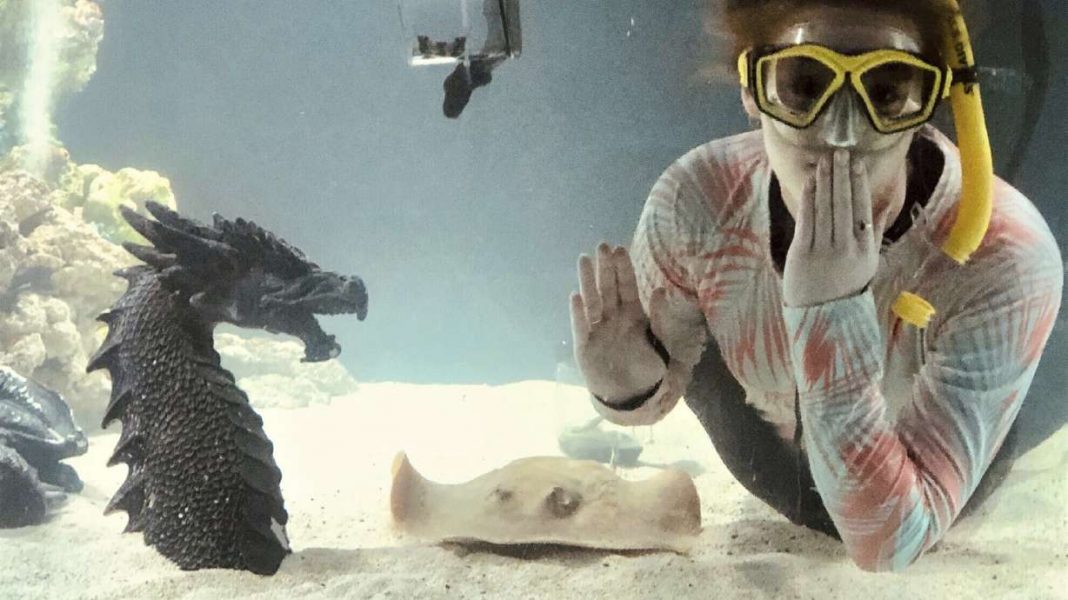Deep in the heart of the Appalachian Mountains in Hendersonville, N.C., a rust-hued stingray named Charlotte, as large as a dinner plate, has spent the majority of her life gracefully navigating the waters of a local aquarium. Despite being a staggering 2,300 miles away from her natural home in the southern Californian waves, and having not encountered a male of her species for at least eight years, Charlotte is miraculously pregnant.
“Our beloved Charlotte is sending us a Valentine’s Day surprise by preparing to welcome some pups!” exclaimed Brenda Ramer, the executive director of the Aquarium and Shark Lab located on Main Street in downtown Hendersonville.
Contrary to some media reports, Charlotte’s pregnancy is not the result of an unlikely interspecies romance with one of the five small sharks she shares her tank with. This was a playful suggestion made by Ramer, but experts have confirmed that such a scenario would be impossible.
The aquarium, managed by Ramer’s educational nonprofit, Team ECCO, aims to inspire local schoolchildren and the wider community to develop a passion for science. Currently, the most significant lesson being taught is about parthenogenesis, a form of asexual reproduction where offspring develop from unfertilized eggs, eliminating the need for a male’s genetic contribution.
This rare phenomenon has been observed in certain insects, fish, amphibians, birds, and reptiles, but never in mammals. Documented instances include California condors, Komodo dragons, and yellow-bellied water snakes.
Kady Lyons, a research scientist at the Georgia Aquarium in Atlanta, who is not affiliated with the North Carolina aquarium, stated that Charlotte’s pregnancy is the only known case of parthenogenesis in round stingrays. However, she is not surprised, as other types of sharks, skates, and rays have experienced similar pregnancies in captivity.
“Nature has a way of making this happen,” Lyons said. “These animals are not cloning themselves. Instead, a female’s egg fuses with another cell, triggering cell division and leading to the creation of an embryo.”
The cell that fuses with the egg is known as a polar body. They are produced when a female is creating an egg but usually aren’t used. “We don’t know why it happens,” Lyons said. “Just that it’s kind of this really neat phenomenon that they seem to be able to do.”
Initially, Ramer and her team thought Charlotte had a tumor when they noticed a lump on her back that was “blowing up like a biscuit.” However, an ultrasound revealed her pregnancy. “We were all like, ‘Shut the back door. There’s no way,” Ramer said. “We thought we were overfeeding her. But we were overfeeding her because she has more mouths to feed.”
Charlotte currently resides in a tank that holds about 2,200 gallons, roughly the size of a construction dumpster. Ramer hopes to acquire a tank nearly twice that size to accommodate Charlotte’s offspring. They also plan to install live cameras for people to observe them.
“It is very rare to happen,” Ramer said. “But it’s happening in the middle of the Blue Ridge Mountains in rural North Carolina, hundreds of miles from the ocean.”
As for the suggestion that Charlotte could have been impregnated by a shark, Lyons said that’s impossible. Besides being different sizes, the animals wouldn’t match up anatomically. Neither would their DNA.
“We should set the record straight that there aren’t some shark-ray shenanigans happening here,” said Lyons, whose graduate work focused on the species.
Round stingrays like Charlotte are abundant on the Pacific coasts of southern California and Mexico, often resting on the ocean’s sandy bottom near the shoreline. They are typically the size of a small dinner plate, and their name comes from their circular shape. They come in all shades of brown. They eat small worms, crabs, and mollusks, and they are preyed upon by certain types of sharks, seals, and giant sea bass.
They’re well known to humans because of their painful sting, often resulting from a beachgoer’s foot stepping on them. Southern California lifeguards encourage people to do the so-called stingray shuffle as they wade through the water, in large part because of round stingrays.
Lyons finds the species fascinating. For example, embryos in the womb are bathed in uterine milk that provides nutrients to help them develop.
“I’m glad the round stingray is getting the media attention that it deserves,” Lyons said. “It’s not necessarily as sexy as a white shark, but they do a lot of really neat stuff.”




Good punctuation and grammar, disagree.